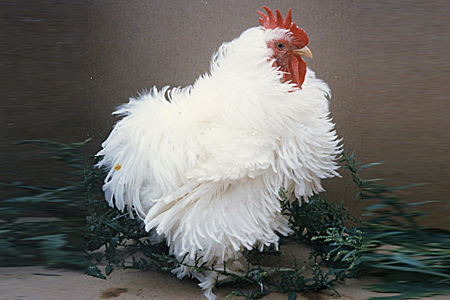
Frizzle chickens are fun and funny, but are they a breed? The answer is yes and no. In Australia, France, Germany, Ireland, Italy, and United Kingdom Frizzles are classified as a pure breed. In the United States they are considered to be a plumage variety in any breed.
Frizzle Chickens
Frizzling is a genetic condition that causes feathers to curl at the ends. Frizzle chickens have been around for centuries, although their country of origin is unknown. Evidence indicates they may have originated in Asia, possibly India.
The American Poultry Association Standard of Perfection first listed Frizzles in 1874. At one time these unique chickens were considered a distinct breed with a single comb. They could be either large or bantam, clean-legged or feather-legged, and one of a limited number of solid colors.
Today Frizzles in the United States are considered to be any breed or variety with frizzled feathers. They are named after the breed that has been frizzled — Frizzle Cochins, Frizzle Polish, and so forth.
The Standard description says, “Frizzles may be shown in any breed and variety set forth in this Standard of Perfection. All sections of the bird should conform to the shape description of the breed,” except that the ends of the feathers curl backward or upward; “the more all the feathers are curved and curled, the better.” The amount of frizzling is controlled by a recessive modifying gene, so getting a perfect frizzle can be tricky.
Frizzledness may be introduced into any breed by mating a member of that breed with a frizzled chicken. Half the offspring will be frizzled and half non-frizzled, although they look alike until the frizzled chicks start developing curled feathers. Some breeds frizzle more easily than others, which is why Cochins and Polish are more often frizzled than some of the other breeds.
Frizzled chickens have less insulative protection from hot, cold, and wet weather than chickens with smooth feathers. On the other hand, frizzled plumage helps heat dissipate more rapidly, making Frizzles better adapted to arid tropics. Since Frizzles can’t fly, they should be provided with low roosting bars.
Frazzle Chickens
A Frazzle is an over-frizzled chicken, also known as an extreme frizzle or curly. Frazzling is the undesirable result of mating two frizzled chickens together. Since the frizzle gene is incompletely dominant, 25% of the offspring will have smooth feathers, 50% will be frizzled, and 25% will be frazzled. The sparse bristle-like feathers of a Frazzle are so brittle they easily break away, leaving the chicken with bare patches.
A Frazzle thus lacks plumage protection against temperature extremes or sunburn. Frazzles are delicate in other ways, including having an enlarged heart, that inhibit survival.
Serious breeders of straight-bred Frizzles keep frizzle-bred normal-feathered hens in their breeder flocks to maintain the desirable curl without the undesirable frazzling. Mating a frizzled rooster to a normal hen yields 50% frizzles and 50% smooth feathered chicks.
Sizzle Chickens
A Sizzle is a cross between a frizzled rooster and a Silkie hen. Unlike the smooth feathers of most chickens, Silkie feathers lack the tiny hooks, or barbicels, that hold a feather’s webbing together. Silkies therefore look like they’re covered with fur. Sizzles have the same fur-like feathers as a Silkie, except they’re curled.
Sizzles are sometimes called frizzled Silkies, or sometimes Frilkies. It all depends on who you talk to. Some breeders insist that Sizzles are either frizzled or smooth feathered (also known as Satin), but never silkie feathered. In contrast, frizzled Silkies, or Frilkies, combine both feather types.
Wading through the confusing Sizzle terminology can be enough to frazzle anyone.
And that’s today’s news from the Cackle Coop.
Gail Damerow, author, The Chicken Encyclopedia


I’m sorry but you are totally wrong about Sizzles. I am one of 3 people that helped create this breed project & I’ve been working on them for over 30 generations. #1 – Their new name is Satin, as we are preparing to present them to the ABA for acceptance as a new breed & they would not accept the name “Sizzzle?. #2 – A frizzled bird with Silkie feathers is NOT a Sizzle or a Satin – it is a frizzled Silkie. #3 – You are correct that a Sizzle/Satin is a cross between a frizzled bird (usually a frizzled Cochin) & a Silkie BUT…it doesn’t have to be a frizzled cock over a Silkie hen, it can also be a Silkie cock over a frizzled hen. #4 – with the first cross, NONE of the chicks will be Silkie feathered – they will all have regular barbed feathers with about 50% frizzled & 50% non frizzled. Silkie feathers won’t appear until the next generation when you cross these chicks with each other or better yet, cross back to a nice unrelated Silkie. It take many generations of dedicated breeding to get a true Satin, which is basically has all the traits of a Silkie with the exception of feather type. Satin feathers are barbed like the Cochin & they have a very fluffy undercoat. Satins come in both regular & frizzled. I would really appreciate it if you would correct your article so it states the true facts about Satins (Sizzles).
I’ve brought your concerns to the attention of the owner who will reach out to the author about a possible revision. Thank you for your insight.